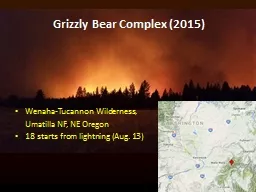PPT-Development and Application of Physiological Markers of Grizzly Bear Health
Author : frogspyder | Published Date : 2020-06-16
David Janz and Lucy Kapronczai Research question Q4 Have changing landscape conditions associated with anthropogenic natural resource extraction activities resulted
Presentation Embed Code
Download Presentation
Download Presentation The PPT/PDF document "Development and Application of Physiolog..." is the property of its rightful owner. Permission is granted to download and print the materials on this website for personal, non-commercial use only, and to display it on your personal computer provided you do not modify the materials and that you retain all copyright notices contained in the materials. By downloading content from our website, you accept the terms of this agreement.
Development and Application of Physiological Markers of Grizzly Bear Health: Transcript
Download Rules Of Document
"Development and Application of Physiological Markers of Grizzly Bear Health"The content belongs to its owner. You may download and print it for personal use, without modification, and keep all copyright notices. By downloading, you agree to these terms.
Related Documents














